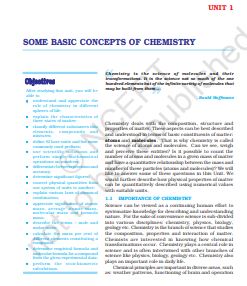‘NCERT Solutions for Class 11 Chemistry Chapter 1‘ PDF Quick download link is given at the bottom of this article. You can see the PDF demo, size of the PDF, page numbers, and direct download Free PDF of ‘Ncert Class 11 Chemistry Chapter 1 Exercise Solution’ using the download button.
NCERT Class 11 Chemistry Textbook Chapter 1 With Answer PDF Free Download

Chapter 1: Some Basic Concepts of Chemistry
1.1 Importance of Chemistry
Science can be viewed as a continuing human effort to systematize knowledge for describing and understanding nature.
For the sake of convenience, science is sub-divided into various disciplines: chemistry, physics, biology, geology, etc.
Chemistry is the branch of science that studies the composition, properties, and interaction of matter.
Chemists are interested in knowing how chemical transformations occur.
Chemistry plays a central role in science and is often intertwined with other branches of science like physics, biology, geology, etc. Chemistry also plays an important role in daily life.
Chemical principles are important in diverse areas, such as weather patterns, functioning of the brain, and operation of a computer.
Chemical industries manufacture fertilizers, alkalis, acids, salts, dyes, polymers, drugs, soaps, detergents, metals, alloys, and other inorganic and organic
chemicals, including new materials, contribute in a big way to the national economy.
Chemistry plays an important role in meeting human needs for food, health care products, and other materials aimed at improving the quality of life.
This is exemplified by the large-scale production of a variety of fertilizers, and improved varieties of pesticides and insecticides.
Similarly, many life-saving drugs such as cisplatin and taxol, which are effective in cancer therapy, and AZT (Azidothymidine) used for helping AIDS victims, have been isolated from plant and animal sources or prepared by synthetic methods.
With a better understanding of chemical principles, it has now become possible to design and synthesize new materials having specific magnetic, electric, and optical properties.
This has to lead to the production of superconducting ceramics, conducting polymers, optical fibers, and large-scale miniaturization of solid-state devices.
In recent years chemistry has tackled with a fair degree of success some of the pressing aspects of environmental degradation.
Safer alternatives to environmentally hazardous refrigerants like CFCs (chlorofluorocarbons), responsible for ozone depletion in the stratosphere, has been
successfully synthesized.
However, many big environmental problems continue to be matters of grave concern to the chemists.
One such problem is the management of the Green House gases like methane, carbon dioxide, etc.
Understanding biochemical processes, the use of enzymes for large-scale production of chemicals, and the synthesis of new exotic materials are some of the intellectual challenges for the future generation of chemists.
A developing country like India needs talented and creative chemists for accepting such challenges.
| Author | NCERT |
| Language | English |
| No. of Pages | 25 |
| PDF Size | 13.3 MB |
| Category | Chemistry |
| Source/Credits | ncert.nic.in |
NCERT Solutions Class 11 Chemistry Chapter 1 Some Basic Concepts of Chemistry
Q1. What do you mean by significant figures?
Ans.
Significant figures are the meaningful digits that are known with certainty. Significant figures indicate uncertainty in the experimented value.
e.g.: The result of the experiment is 15.6 mL in that case 15 is certain and 6 is uncertain. The total significant figures are 3.
Therefore, “the total number of digits in a number with the last digit that shows the uncertainty of the result is known as significant figures.”
2. Express the following in the scientific notation:
(i) 0.0048
(ii) 234,000
(iii) 8008
(iv) 500.0
(v) 6.0012
Ans.
(i) 0.0048= 4.8 ×10^{-3}10−3
(ii) 234,000 = 2.34 ×10^{5}105
(iii) 8008= 8.008 ×10^{3}103
(iv) 500.0 = 5.000 ×10^{2}102
(v) 6.0012 = 6.0012 ×10^{0}100
Q3. How many significant figures are present in the following?
(a) 0.0025
(b) 208
(c) 5005
(d) 126,000
(e) 500.0
(f) 2.0034
Ans.
(a) 0.0025: 2 significant numbers.
(b) 208: 3 significant numbers.
(c) 5005: 4 significant numbers.
(d) 126,000:3 significant numbers.
(e) 500.0: 4 significant numbers.
(f) 2.0034: 5 significant numbers.
Q4. Round up the following up to three significant figures:
(a) 34.216
(b) 10.4107
(c)0.04597
(d)2808
Ans.
(a) The number after round up is: 34.2
(b) The number after round up is: 10.4
(c)The number after round up is: 0.0460
(d)The number after round up is: 2810
Q5. Calculate the molar mass of the following:
(i) CH_{4}CH4 (ii)H_{2}OH2O (iii)CO_{2}CO2
Ans.
(i) CH_{4}CH4 :
Molecular mass of CH_{4}CH4 = Atomic mass of C + 4 x Atomic mass of H
= 12 + 4 x 1
= 16 u
(ii) H_{2}OH2O :
The molar mass of water H_{2}OH2O
The atomic mass of H = 1
The atomic mass of O = 16
H2O = 2×H+1×O
Molar mass of water = 2×1+16 = 18g/mol
(iii) CO_{2}CO2 :
Molecular mass of CO_{2}CO2 = Atomic mass of C + 2 x Atomic mass of O
= 12 + 2 × 16
= 44 u
Some Basic Concepts of Chemistry Textbook With Solutions PDF Free Download
